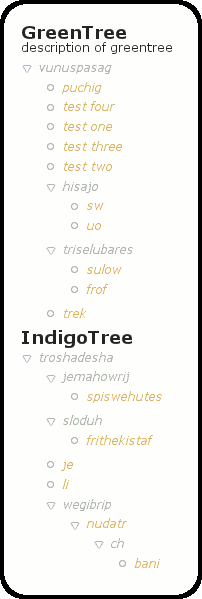 Support for Drupal 7 is ending on 5 January 2025—it’s time to migrate to Drupal 10! Learn about the many benefits of Drupal 10 and find migration tools in our resource center.
Support for Drupal 7 is ending on 5 January 2025—it’s time to migrate to Drupal 10! Learn about the many benefits of Drupal 10 and find migration tools in our resource center.This project is not covered by Drupal’s security advisory policy.
*** This module is now unmaintained. Please read the closing post on the queue for further details. Rob. ***
No activity recently, so V7 is going to first release. Please run 'update.php'! It works in a minimal way with Sitemap and Nice Menus. Hurrah! Read about it here.
Drupal Versioning go here.
***
Intro
Makes custom menus from selected branches of a taxonomy.
People keep asking for this. They keep getting told that it's not possible, it's not Drupal, and "who would want it anyway?" For all you impossible people out there, here is Taxonomy Treemenu.
But what does it do?
Designers have no problem understanding what this means. Classify content without ever seeing a database? Drupal's taxonomy is excellent, yes? But a user can't see your structure. Wouldn't it be groovy if they could?
For everyone besides designers, here's a list of some of Taxonomy Treemenu's current features,
- As many menus as you like, any depth, any vocab/term root, nodes or not, in pages or blocks. Page menus can't currently backtrack (we know it can be done though, so don't write us off)?
- Full 2D menus, not lists. Same as the 'navigation' menu.
- Has limited but now sophisticated Views integration. So pull up those taxonomy based Views easily.
- Auto-update if you change the taxonomy.
- DHTML Menu module? On a page or in a block.
- Mostly uses the normal Drupal custom-menu admin pages, because they are Drupal custom-menus.
- Works with multiple hierarchies.
- Many options, such as 'order node links' right in the admin. Work at a high level and have better long term maintainability (This is where users start rallying for the module).
- Will inherit node counts and do combined term lists, if visitors to your site need a drill-down experience.
- Lots of templating and themes to work with, including a built in 'links only' term theme. Start on your site straight away, not figuring out how the module works.
- Page after page of help and, if installed, the Advanced Help module will put the help into the admin pages.
- Plenty of theming code snippets, and support functions too. Certain configurations of menu can be styled by taxonomy values (put a gemstone image into your jewellry section?).
There's more, plenty more. More possibilities than we can figure out. Yet it's all very simple for the administrator, you should see a menu in minutes, not an afternoon.
Where would you use it?
You want to index relatively stable parts of your content, e.g 'forum topics', using a 2D menu, like the 'navigation' menu. And you want to give that to your users.
Or build your site on a taxonomy. Taxonomy Treemenu can knock out sidebars and sitemaps in five minutes. And it auto-updates.
Anywhere where you can spare the space for a 2D menu and you'd like your users to have full access to the wonder of your content.
Notes
Want to see what it's all about in a couple of minutes? Install and follow the instructions in the QUICKSTART file. This information is now duplicated within the interface, using the Advanced Help module.
Taxonomy Treemenu goes about it's job by taking a user selected vocabulary or term from the taxonomy, automatically growing the tree underneath, and saving the lot as a proper Drupal custom menu. It then skips and dips round Drupal rendering to get the information you need to the user.
If you are sampling modules to try and meet your needs, you might want to read, or even contribute to, our Comparision of menu handling modules (With relevance to Taxonomy) page.
WARNING: this is a module with ongoing and churning development. It has often relied on developer testing. However, the worst damage ever caused was loose links scattered through the menu links table - an error which can be fixed by an uninstall. For the user, the API has remained consistent and there are features for your protection - this is not a project which disclaims interest in your installation. The developers are always willing to help those who wish to experiment with the module.
Project information
Seeking new maintainer
The current maintainers are looking for new people to take ownership.- Module categories: Content Display, Site Structure
21 sites report using this module
- Created by rcrowther on , updated
This project is not covered by the security advisory policy.
Use at your own risk! It may have publicly disclosed vulnerabilities.











